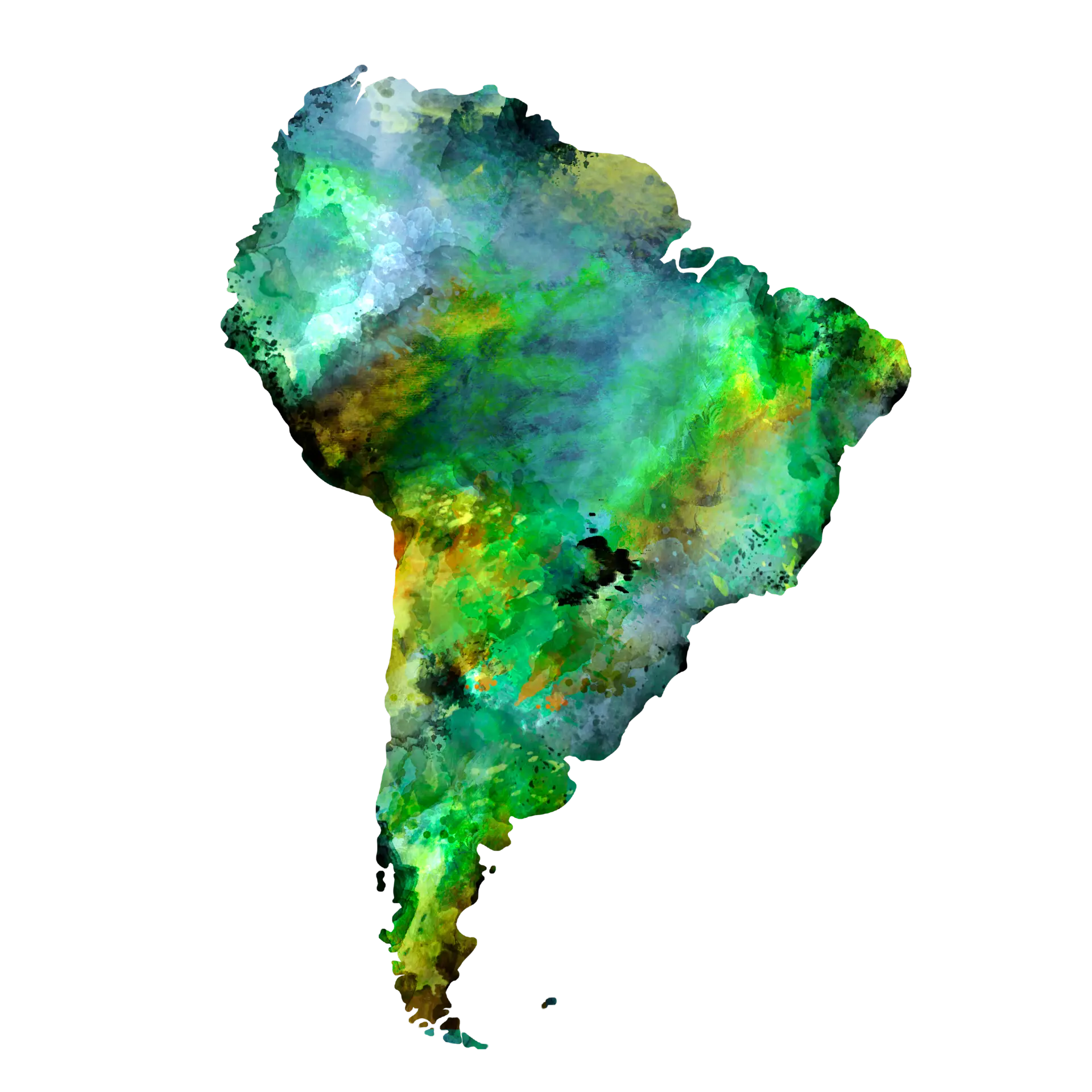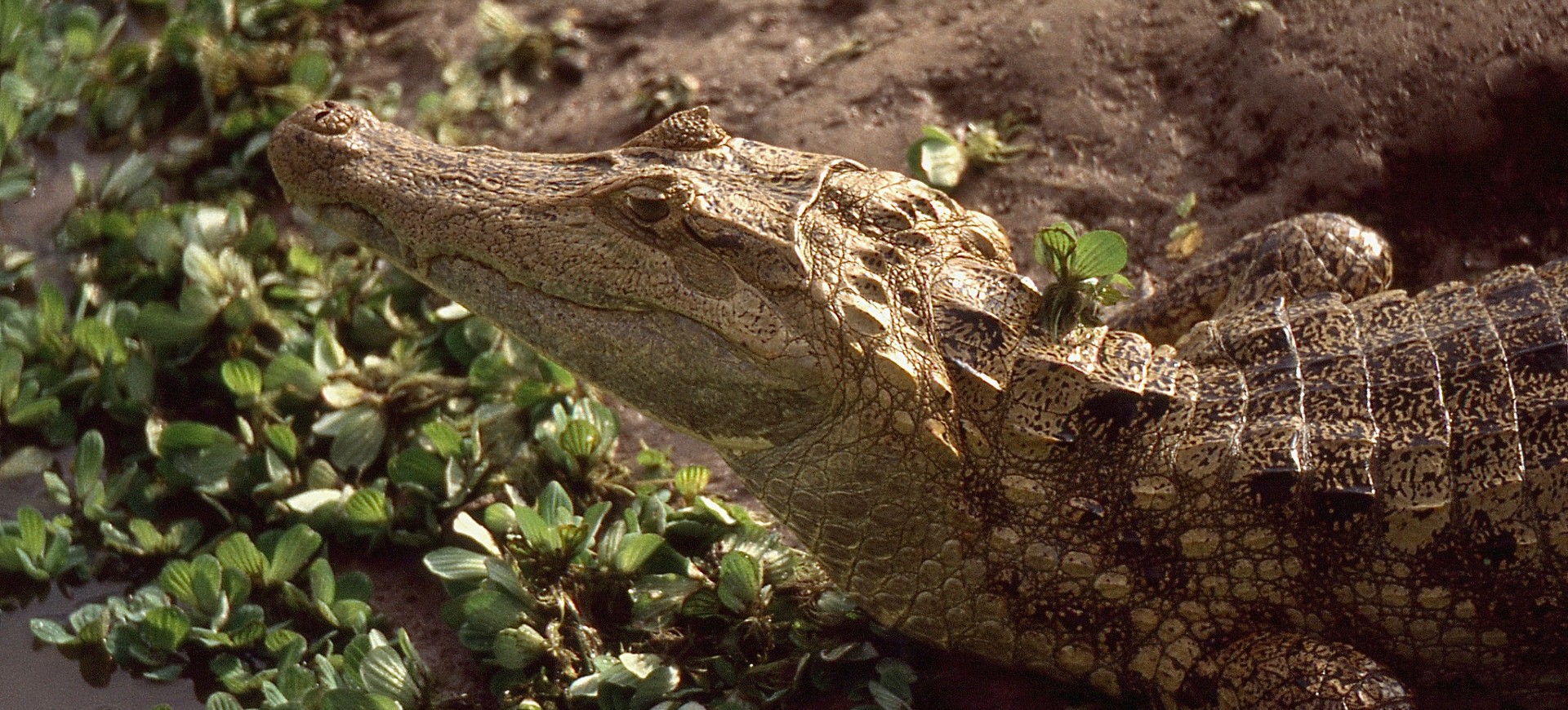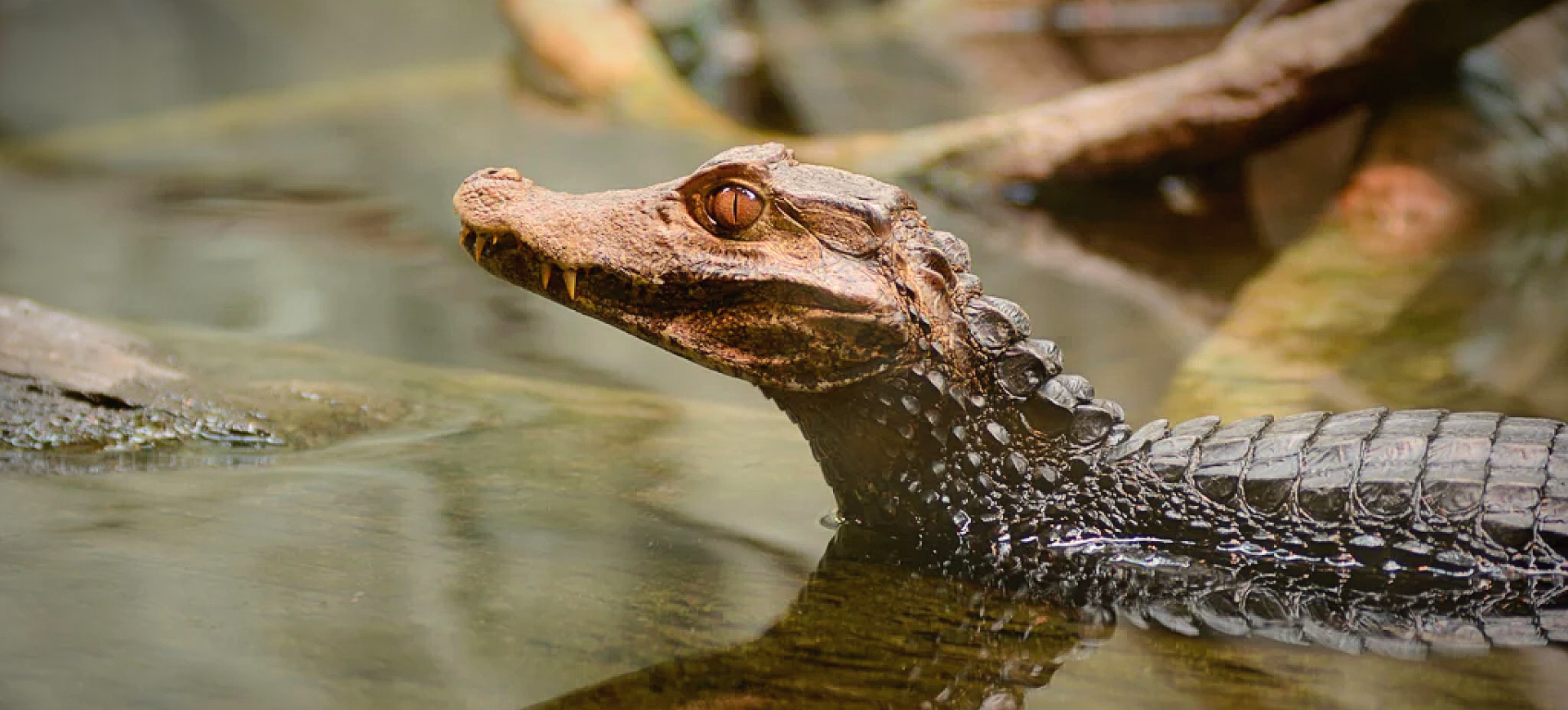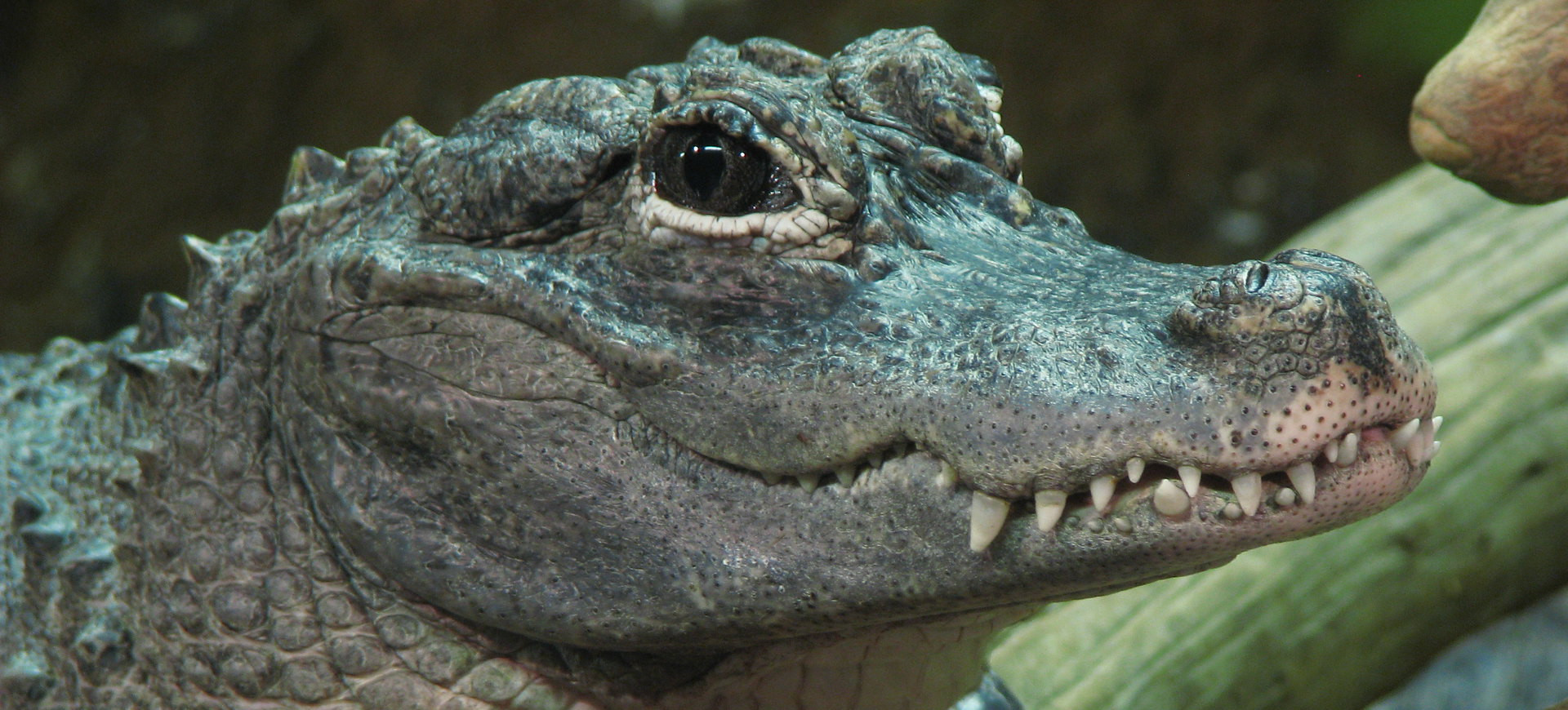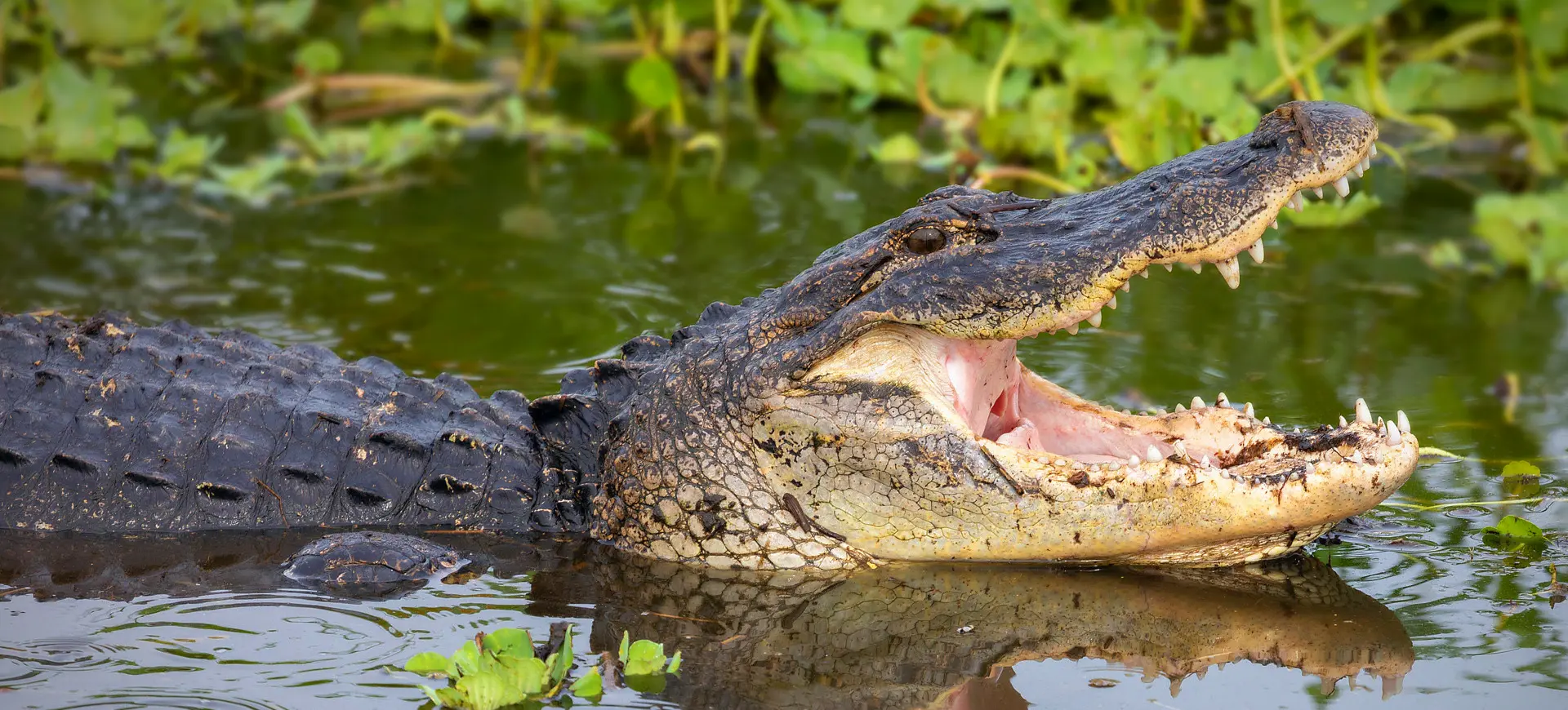Overview
The black caiman is one of the largest crocodilian species and a top predator in the freshwater ecosystems of South America. It derives its name from its dark, almost black coloration, providing excellent camouflage in its rainforest habitat’s shadowy waters. This nocturnal predator primarily hunts at night, preying on various species, including fish, birds, reptiles, and mammals. As an apex predator, the black caiman plays a critical role in maintaining the balance of its ecosystem by regulating prey populations.
This species is known for its powerful jaw and robust body, which allow it to take down large prey, including capybaras and even anacondas. Juvenile black caimans have a lighter coloration with yellowish bands across their bodies, which fade as they age. The black caiman spends much of its time submerged in water, with only its eyes and nostrils visible above the surface, making it an efficient ambush predator. Despite its fearsome reputation, the species faces numerous threats, including habitat loss and hunting for its skin, which is prized in the leather industry.
Black caimans are primarily found in slow-moving rivers, lakes, and wetlands within the Amazon Basin. They are closely related to alligators but can be distinguished by their larger size and darker coloration. Due to their size, black caimans have fewer natural predators than other caiman species, although jaguars and large anacondas may occasionally target juveniles. Once heavily hunted, conservation efforts and legal protections have helped stabilize some populations, though threats from human activity remain significant.
Taxonomy
Kingdom
Phylum
Class
Order
Family
Genus
Species
Type
Current distribution:
Black caimans are found primarily in the Amazon Basin, spanning Brazil, Peru, Colombia, Venezuela, Ecuador, Bolivia, and Guyana. Their populations are most concentrated in protected regions like national parks and wildlife reserves. Historically, the species was distributed across a much broader range, but overhunting and habitat destruction have caused significant range contractions. They are now often found in isolated pockets where suitable habitat remains.
In Brazil, black caimans are particularly abundant in the flooded forests of the Amazon River and its tributaries. In Peru, they are commonly observed in the Amazon rainforest's lowland wetlands and oxbow lakes. Their range overlaps with human settlements in some areas, leading to occasional conflict as they prey on livestock or become a threat to local communities. Conservation efforts aim to preserve their remaining habitats and mitigate human-wildlife conflicts, though enforcement can be challenging in remote areas.
Physical Description:
The black caiman is a massive reptile with a broad, elongated snout and dark, rough scales that provide excellent camouflage in its environment. Adults are predominantly black, with lighter grayish or white markings on their lower jaws and throat. Juveniles display yellowish crossbands on their bodies and tails, which serve as camouflage to protect them from predators. The species has powerful legs and webbed feet, allowing it to move effectively on land and in water.
The black caiman’s armored body is covered in osteoderms, or bony plates, which protect against potential threats. Its teeth are sharp and conical, designed to grip and hold prey with immense force. Its eyes are adapted for nocturnal vision, giving it an advantage when hunting in the dark. Adult males can grow significantly larger than females, and individuals can reach lengths of up to 20 feet (6 meters), making them one of the largest reptiles in the world.

Lifespan: Wild: 50 Years || Captivity: 70 Years

Weight: Male: 880–1100 lbs (400–500 kg) || Female: 220–440 lbs (100–200 kg)

Length: Male: 144–192 in (365–488 cm) || Female: 96–120 in (244–305 cm)

Top Speed: 10 mph (16 km/h)
Characteristic:
Native Habitat:
The black caiman inhabits freshwater ecosystems throughout the Amazon Basin, including rivers, lakes, floodplains, and swamps. It prefers slow-moving or stagnant waters with abundant vegetation, which provides cover for hunting and nesting. Seasonal flooding of the Amazon River creates ideal conditions for the black caiman, offering ample hunting grounds and juvenile protection. During the dry season, it may congregate in remaining water bodies and face increased resource competition.
Their habitat overlaps with several other crocodilian species, such as spectacled caimans, though black caimans dominate due to their larger size. They are well-adapted to their aquatic environment but can also move on land when necessary, such as seeking nesting sites or relocating during droughts. Large trees and dense vegetation along riverbanks provide shade and nesting areas. However, human activities such as deforestation, mining, and agriculture are increasingly threatening their natural habitat.
Climate Zones:
Biomes:
WWF Biomes:
Biogeographical Realms:
Continents:
Diet:
Diet & Feeding Habits:
The black caiman is a carnivorous apex predator that feeds on various prey depending on size and age. Juveniles primarily consume smaller prey, such as insects, crustaceans, and small fish. As they grow, their diet expands to include larger animals, such as turtles, birds, capybaras, and deer. Adult black caimans have been known to prey on large animals, including tapirs and even smaller caimans or anacondas.
Black caimans are opportunistic hunters who rely on their excellent night vision and ambush tactics to catch prey. They often lie motionless in the water, waiting for unsuspecting prey to approach before launching a swift attack. Once they capture their prey, they use their powerful jaws to subdue it and, if necessary, perform a “death roll” to tear it apart. Without large prey, they can also scavenge for carrion or hunt smaller animals opportunistically.
Mating Behavior:
Mating Description:
Black caimans are polygynous, with dominant males mating with multiple females during the breeding season. Mating typically occurs during the wet season, when water levels are high, providing optimal conditions for raising offspring. Males attract females by vocalizing and creating disturbances in the water, such as slapping their heads against the surface. After mating, the female constructs a nest using vegetation and mud along riverbanks or shallow areas.
The incubation lasts approximately 65–90 days, during which the female guards the nest from predators, such as jaguars and other reptiles. Once the eggs hatch, the mother helps her offspring emerge and may carry them to the water in her mouth. Hatchlings are highly vulnerable to predation and rely on their mother for protection during their early weeks of life. Black caimans are oviparous, and clutch sizes typically range from 30 to 60 eggs.
Reproduction Season:
Birth Type:
Pregnancy Duration:
Female Name:
Male Name:
Baby Name:
Social Structure Description:
Black caimans are generally solitary, except during the breeding season or when mothers care for their offspring. Dominant males establish territories during the wet season and compete for access to females, often engaging in aggressive displays. Outside the breeding season, adults are not highly social and tend to avoid contact with one another. Juveniles, however, may congregate in nursery groups for added protection under the watch of a female.
Communication among black caimans includes vocalizations such as bellows, grunts, and hisses, particularly during mating or when signaling distress. Hatchlings use high-pitched calls to alert their mother to danger or request assistance. Despite their solitary nature, black caimans share their habitat with other crocodilian species, although they dominate due to their larger size. Social interactions are generally limited to mating and maternal care, with minimal cooperation or group behavior observed.
Groups:
Conservation Status:
Population Trend:
The black caiman was once heavily hunted for its skin during the mid-20th century, leading to a dramatic population decline. Since implementing conservation measures and hunting bans, their numbers have rebounded in many areas, though they remain locally threatened in some regions. In parts of their range, populations are stable, particularly within protected areas like national parks and reserves. However, populations outside these protected zones are still at risk from habitat loss, hunting, and human-wildlife conflict.
In some areas, illegal hunting and poaching continue to pose significant threats, particularly in regions where wildlife protection laws are not enforced. Habitat destruction due to logging, agriculture, and mining further exacerbates the decline of local populations. Conservation efforts focus on habitat protection, enforcement of hunting bans, and community-based education programs to reduce conflict. Monitoring programs have been established to track population trends and assess the effectiveness of conservation initiatives.
Population Threats:
The most significant threats to black caimans are habitat destruction and fragmentation caused by deforestation, agriculture, and mining activities. Wetland drainage and river pollution also degrade aquatic habitats, reducing food availability and nesting areas. Although hunting for their skin is banned, it continues illegally in some regions, as black caiman leather is highly valued. Additional local communities sometimes kill them out of fear or to protect livestock.
Climate change poses a long-term threat by altering rainfall patterns, potentially disrupting their breeding cycles and wetland habitats. Juveniles face high predation rates from predators like jaguars, large snakes, and birds of prey. Human-wildlife conflict is another growing concern, as black caimans occasionally prey on livestock or conflict with people fishing or swimming in their habitats. Without continued conservation efforts, these threats could lead to localized population declines, even in areas where the species is currently stable.
Conservation Efforts:
Legal protections, such as bans on hunting and trade, have been critical in stabilizing black caiman populations in recent decades. Protected areas within the Amazon Basin, such as the Mamirauá Sustainable Development Reserve in Brazil, serve as key strongholds for the species. Community-based conservation programs aim to reduce human-caused mortality by educating locals about the ecological importance of black caimans and promoting coexistence. Sustainable ecotourism initiatives generate income for local communities while raising awareness about the species.
Research and monitoring programs have been established to study black caiman populations and their ecological role in freshwater ecosystems. Efforts to restore and preserve wetland habitats are essential for ensuring their long-term survival. International organizations such as CITES regulate crocodilian product trade, helping curb illegal hunting. Despite these efforts, continued funding, enforcement, and habitat preservation are necessary to address ongoing threats.
Additional Resources:
Fun Facts
- Black caimans are the largest caiman species and among the largest crocodilians in the world.
- Their dark coloration helps them absorb heat and blend into the water’s surface during nighttime hunting.
- They have a “third eyelid,” called a nictitating membrane, that protects their eyes while swimming.
- Black caimans can stay submerged for over 30 minutes, waiting to ambush prey.
- Juvenile black caimans are brightly colored with yellow crossbands for camouflage against predators.
- Their ancestors date back to the Late Cretaceous period, over 80 million years ago.
- The powerful “death roll” technique is used to dismember large prey into manageable pieces.
- Black caimans are considered “keystone species,” meaning they are critical in maintaining the health of their ecosystem.
- Their vocalizations can travel long distances through water to communicate with other caimans.
- Despite their fearsome reputation, attacks on humans are rare and typically occur when caimans are provoked or feel threatened.

